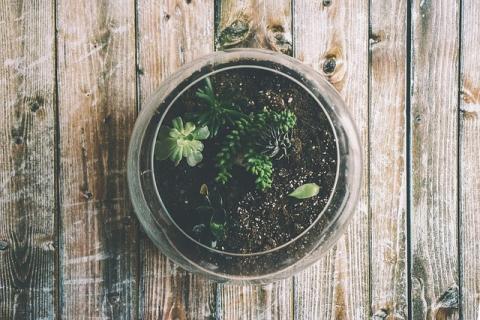
Now that there are apparently several more weeks of winter (thanks, Mr. Groundhog), it is the perfect time to find creative ways to incorporate more green into your life. Not only is a thriving, jungle-like terrarium lovely in the colder, winter months when we’re all too ready for spring, but a cleverly crafted terrarium can bring joy throughout all of the seasons. A terrarium can also serve as a beautiful reminder that we all live and thrive in a constantly exchanging ecosystem; like the colorful plants, thick moss and other features respiring together in a glass vessel – like a snow-globe in summer (no snow!) – we make up a magical world where living in harmony is beautiful.
Building a terrarium is a perfect do-it-yourself project that nearly maintains itself after you’ve done the assembly – what’s not to love about that? Not to mention, terrariums are incredibly versatile. Put one on your desk at work, on the kitchen island, as the centerpiece on your dining room table or for a party, on a windowsill; keep it covered, let it stand open, hang it, gift it, make it mini, make it big…a terrarium is meant to be personalized for however you’re inspired!
Although you may find DIY terrarium kits here, constructing your own terrarium allows you to be inventive with what you use. You may certainly purchase a geometric container or uniquely shaped glass bowl to use, but I love the idea of repurposing a slightly neglected glass receptacle that I already have at home. Here are some other guidelines to consider when you assemble your own little terrarium wonderland:
1.Closed terrarium (moisture-loving plants) or open terrarium (moisture-rich plants)?
Certain plants work better in a closed container versus an open container. Plants like ferns and tropical plants prefer to be in a warmer, moister, greenhouse-like environment. Succulents and cacti prefer to be in a drier, sparser environment. Both require the same maintenance, but a closed terrarium more or less waters itself through the process of transpiration, while an open terrarium requires a drink every week or so. Opening closed terrariums for part of a day every 7-10 days is advised.
2.Do-it-yourself with items from home, or use a bigger budget?
Depending on where you live, it can be fairly easy to collect most of the items you need for a terrarium around your home. Repurpose a vessel, grab some gravel from the driveway, some ash from your woodstove, some moss from a tree…or, buy a special container, some activated charcoal, a coir brick (made from coconut husk fiber), and fiberglass screen for between your drainage gravel layer and your soil.
3.Choose plants that will stay small and manageable.
For your closed terrarium, ferns, mosses, orchids and bromeliads are best. For an open terrarium, succulents such as these are great, and air plants are wildly easy to manage, only requiring a weekly spritz of water and no soil. When you open your terrarium to breathe every 7-10 days, trim back foliage as needed at the same time.
4.Layer your terrarium appropriately.
The standard procedure for constructing the optimal terrarium ecosystem generally layers (relative to the size of your container) ½-2 inches of gravel first, followed by window screen if you like, to keep the soil from draining through the gravel, and a 1:3 activated charcoal to humus potting soil or coir mix filling your container to about twice the height of the gravel layer. When you transplant your plants, ensure that they are snug in the soil.
5.Love your terrarium!
Use tweezers to place moss and extra features like rocks, seaglass, driftwood, figurines, or other items that inspire you. Place your terrarium in indirect sunlight, meaning not in the brightest window, but maybe on a surface that sees light for 2-3 hours of the day. Give your terrarium a modest drink – not too much – and watch nature do its work!








